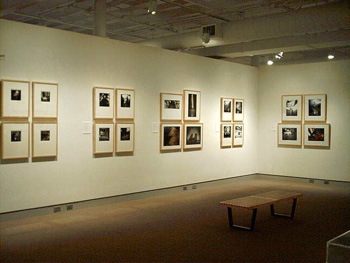|
Gallery
Five
"The Prospect of Light:"
An exhibition of photographic images made with plastic and pinhole
cameras.
January
23 - March 27, 2004
The
University of Maine Museum of Art
Bangor, Maine
Curated
by Jonathan Bailey and Wally Mason

Given my personal involvement with the plastic "Diana"
camera dating back to 1979, I was delighted at the opportunity to
co-curate an exhibition of low-tech images with my good friend and
fellow photographer Wally Mason (director and curator of the University's
Museum of Art). It was fascinating for me to be on the other side
of the fence and see what it takes to choose and then to mount an
exhibition like this from beginning to end. We did not set out to
do the "definitive" low-tech exhibition, but simply gathered
together from over 100 artist's submissions what we hoped would
be a cohesive and compelling group show.
Some background
for those of you who might wonder why photographers might opt to
use such primitive equipment:
The real asset
with plastic and pinhole cameras is the ability to work spontaneously
and intuitively. There simply are no mechanisms on the camera to
manipulate to distract you from the picture taking process. One
exposes film more freely.
It is interesting
to note that the recent rise of high-tech photography in the form
of digital imaging and digital manipulation of images has in many
ways encouraged a resurgence of interest in more "handmade"
approaches to the photographic image - complete with all the foibles
and "imperfections" inherent in the process. Many artists
simply need to have their hands on the tools and materials - to
be more in direct contact than "modern" cameras and digital
printing processes allow.
The author Thomas
Moore explains that "technology" today is commonly understood
to reference machines and instrumentation and is often thought of
in relation to progress or to the "advancement" of humankind
through inert devices.
He goes on to
contrast this present day understanding with that of the ancient
Greeks who understood the word to encompass a much broader meaning
including "an art or craft, art skill, cunning of hand, craftsmanship,
an artful device, a method of making or doing." (From Thomas
Moore's Meaningful Work.)
It is against
this backdrop of deeper allusions that we present this exhibition
of low-tech imagery.
* The
Plastic Camera Artists:
I believe it
was Arnold Gassan - teaching at Ohio (State?) in the mid- to late-60's
- who first had his photo students go out and work with the Diana
camera. Since then, there has been a bit of an underground "cult"
for these cameras.
The Diana cost
$2 at "Five and Dime" stores and were given away as carnival
prizes and for cereal box tops. They were produced under many different
names (Dory, Banner, etc) - but they always were the identifiable
blue and black cameras. Dianas ceased being produced in Hong Kong
in the early 1980's - and the molds for the camera were destroyed.
Their continued popularity - indeed, their increasing popularity
- gave rise to the "Holga" camera going into production
to satisfy the demand. Holgas are widely available and cost approximately
$25. Dianas are still available on eBay and typically fetch $100
- and not uncommonly as much as $200!
--
click any image for larger version --
*
The Pinhole Camera Artists:
The "pinholer"
is a different sort of animal from the plastic camera user. They
are, I have observed, really more akin to a traditional view camera
photographer. They do, however, share with the plastic-camera user
a desire for simplicity and towards keeping the tools at their most
"elemental."
The pinhole
camera is usually used on a tripod (the Diana doesn't even have
the ability to mount to one!) and the exposures are seconds in length
- if not minutes. Like a view camera, this fact necessitates a more
deliberate and "studied" approach to image-making. Many
pinholers use laser-drilled pinholes for greater accuracy of measurement.
And, while it is not necessary for good results, many pinholers
are quite exact in their mathematics: figuring out the relationship
between the pinhole's size, its distance to the film, and thus its
corresponding focal length. It's interesting to note the images
from these "lens-less" cameras often have sharper detail
than the plastic camera can deliver….
*
Other noteworthy artists whose work we also considered:
(or, there's only so much wall space….)
The
Galleries
home
|